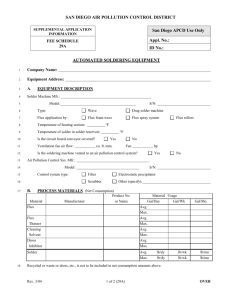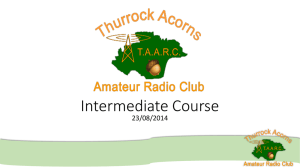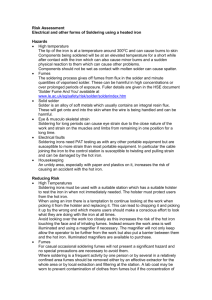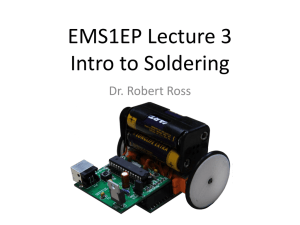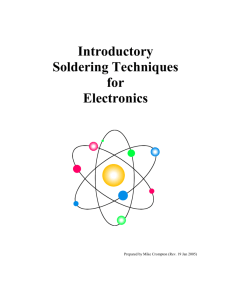Block 4 - Unit 2.2 Soldering Notebook
advertisement
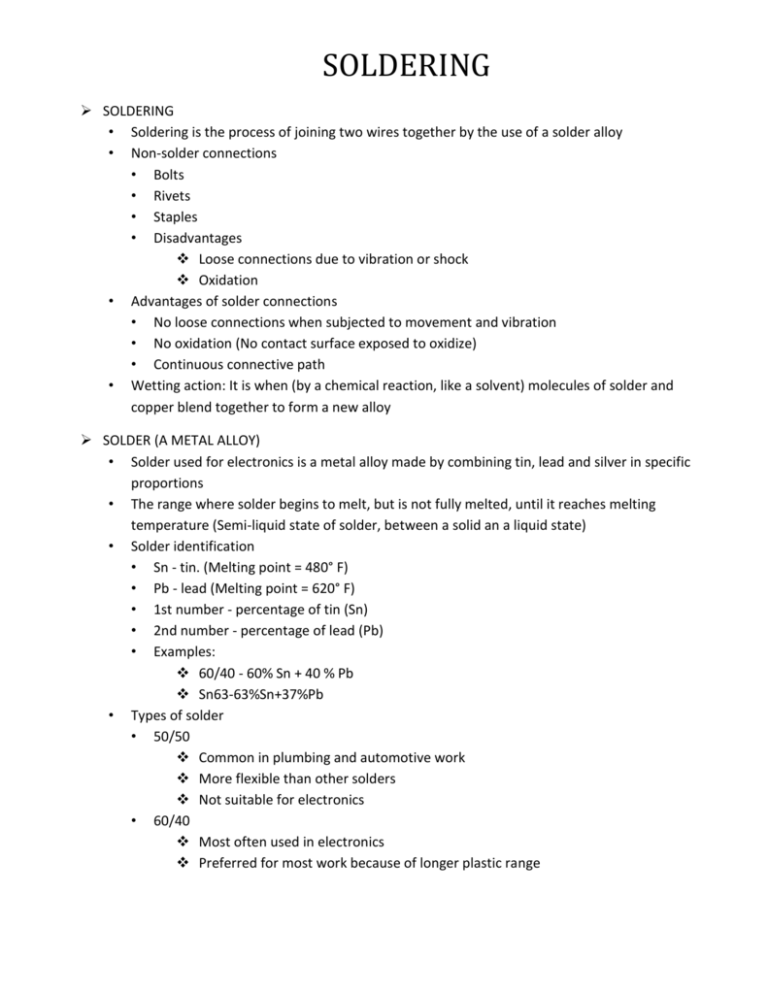
SOLDERING SOLDERING • Soldering is the process of joining two wires together by the use of a solder alloy • Non-solder connections • Bolts • Rivets • Staples • Disadvantages Loose connections due to vibration or shock Oxidation • Advantages of solder connections • No loose connections when subjected to movement and vibration • No oxidation (No contact surface exposed to oxidize) • Continuous connective path • Wetting action: It is when (by a chemical reaction, like a solvent) molecules of solder and copper blend together to form a new alloy SOLDER (A METAL ALLOY) • Solder used for electronics is a metal alloy made by combining tin, lead and silver in specific proportions • The range where solder begins to melt, but is not fully melted, until it reaches melting temperature (Semi-liquid state of solder, between a solid an a liquid state) • Solder identification • Sn - tin. (Melting point = 480° F) • Pb - lead (Melting point = 620° F) • 1st number - percentage of tin (Sn) • 2nd number - percentage of lead (Pb) • Examples: 60/40 - 60% Sn + 40 % Pb Sn63-63%Sn+37%Pb • Types of solder • 50/50 Common in plumbing and automotive work More flexible than other solders Not suitable for electronics • 60/40 Most often used in electronics Preferred for most work because of longer plastic range • • 63/37 Known as lead free solder Has no plastic range (more difficult to master use) Used in high density, high reliability circuitry (missies, satellites, computers, with conformal coatings) Flux • Flux removes oxides and keeps them removed during soldering • Melts at a lower temperature than solder • Types of flux Acid flux - not used in electronics Rob Rosin flux - only one used in electronics Flux cored solder - controlled amount of flux used at a solder joint SOLDERING IRONS • Basic elements • Resistance heating unit • Heater block 3 • Types of solder irons • Fixed heater • Temperature controlled by operator • Temperature controlled by built in magnetic switch • Operator controlled temperature sensor • Controlling heat at the solder joint • Relative thermal mass vs. heat cycle Single pad - little mass Double sided pad with plate through holes Multi-layer boards Lead mass - Temperature rise is relative to tip mass vs. work mass (Not tip temperature) Terminal mass Reservoir size Recovery rate (Ability to sustain heat - like a reservoir) o Block size (Heating reservoir) o Wattage - heating element If more heat is needed at the joint, use a larger tip and/or increase the core capacity For the practical exercise, adjust heat control to a normal range of "7" to "8" for soldering iron • Surface condition of pads or leads Oxides and contaminants Cannot create good solder joint on dirty surface Clean surface before soldering Use abrasive stick (eraser) • • • • • • Thermal linkage • Area of contact between iron tip and work • Apply solder between tip and work piece to create a and increase thermal linkage and speed up heat transfer (The secret of craftsmanship) • The reaction of the work piece to the work actions being performed on it (in soldering heat rate recognition) • It is in the sensing of the change by sight, sound, smell and touch • In soldering the primary indicator is heat rate recognition • If tip is too large and too hot - heat rate too fast • If tip is small - heat rate too slow (mush melt) • Get in and out as fast as you can • Using the hottest iron available you should spend no more than 1-2 seconds on a particular joint being soldered, to prevent damage • The key work piece indicator for soldering, therefore, is sight. Selecting and handling the soldering iron • 30 watt pencil type with changeable tips is a good general purpose iron for electronic soldering • Unplated tips - copper type • Plated tips - iron type • Fully insert the and tighten the tip • Tin unplated tip when not using • Before using soldering iron, wipe tip off on a damp sponge to "shock off' (remove) any oxides • Always store iron in holder (Pace "cubby") when not in use WIRE STRIPPERS • Mechanical stripper Clean strip without deforming or nicking wire Must use correct stripper notches V-notch stripper • Blades do not conform to wire • Easy to nick wire Stripper • Best method • Heat tips to melt or soften insulation and rotate lead, then pull off insulation prevents nicking of wire • Can be used for PVC (low temp) or Teflon (high temp) insulation • For the practical exercise, adjust heat control to a normal range of "7" to "8" for the thermal stripper SOLDER JOINTS • Acceptable straight through lead • Length of wire above pad = radius of pad • .Smooth surface • Well feathered out smoothly to the edge • No pits or holes • No evidence of flux or flux pockets • Surface bright and shiny, free of any lumps • Slightly concave, with minimum amount of solder needed to make the connection • Acceptable clinched lead • Length of wire = diameter of pad • Shape. of wire apparent beneath solder • Smooth surface • Well feathered out to the edge • No pits or holes • No evidence of flux • Surface bright and shiny • Slightly concave • Unacceptable solder joints • joint Too little heat applied There is still a quantity of solidified flux between wire and terminal • joint Heat withdrawn too soon, solder does not become liquid Solder beaded up and may also show peaks • joint Movement of wire during solidification, ,before solder cools Looks frosty, dull, rough, granulated and may show cracks • joint Repeated effort to reheat joint that will not properly wet due to contamination or lack of sufficient flux It is chalky, dull or crystalline in appearance, and may show pitting on the surface TERMINALS • Terminal • Wrap of wire can be 180°, 270° or 360° • We will use 270 degree wrap in practical exercise • Entry location If only one wire, it is placed in the lower section, flat down against base Two wires come in from same direction and are stacked • Insulation gap - one to two times wire diameter is permissible • Terminal • Used to attach wire to circuit board • Resistance soldering tool • Useful in close quarters / limited lateral space Electrodes can be positioned when cold • No danger of heating wrong area • Turn off power to tool to avoid arcing Terminal • Entry of wire from side, top and bottom • Wrap may be 90° or 180° • Terminals • Hook Terminal Found on hermetically sealed relays Wire wrap normally 90°, for repair work 270° recommended • Pierced Terminal Has hole or eye Wrap of wire 90° to 270° COMPONENT SOLDERING - AXIAL LEAD (RESISTORS) • Clean component leads and solder pads • With abrasive stick • Then with solvent (alcohol) • Bend component leads • Use Conform tool • Clean again with solvent (alcohol) • Insertion - clenched lead • Cut lead one pad diameter exposed beyond insertion hole • Press (bend) exposed end of lead flat against circuit board (with component fully inserted and flat against other side of board). • Soldering: (after flux application) • Touch the joint first (position so as to make solder bridge between component lead and pad). • Soldering tip contacts the lead • Paint the solder onto the joint, while moving the tip • Sweep the end of the lead last • Inspect your work
